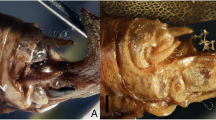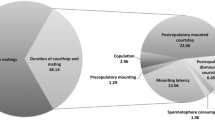Abstract
This is the first substrate-borne communication record of the troglobitic planthopper Typhlobrixia namorokensis in the caves of the Ambovonomby network, Namoroka Tsingy, Madagascar. A supplementary morphological description of the male genitalia is provided and, for the first time, female genitalia of T. namorokensis are characterized. Molecular data were obtained for T. namorokensis; molecular analysis also reveals the presence of another (yet unidentified) cavernicolous cixiid in the Antsifotra caves network. The evolutionary origin of T. namorokensis is discussed. Its adaptation to caves and its behaviour allows its identification as a true troglobiont. Its vibrational signal structure is compared to the calls of other cave-dwelling cixiids.









Similar content being viewed by others
References
Audacity Team (2012) Audacity (Version 2.0.2) [Computer program]. Retrieved December 12, 2012, from http://audacity.sourceforge.net
Booij CJH (1982) Biosystematics of the Muellerianella complex (Homoptera, Delphacidae), interspecific and geographic variation in acoustic behaviour. Z Tierpsychol 58:31–52
Bourgoin T (1993) Female genitalia in Hemiptera Fulgoromorpha, morphological and phylogenetic data. Ann Soc Entomol Fr 29(3):225–244
Bourgoin T (2015) FLOW (Fulgoromorpha Lists on The Web): a world knowledge base dedicated to Fulgoromorpha, version 8. http://www.hemiptera-databases.org/flow. Accessed 19 May 2015
Bourgoin T, Huang J (1990) Morphologie comparée des genitalia mâles des Trypetimorphini et remarques phylogénétiques (Hemiptera: Fulgoromorpha: Tropiduchidae). Ann Soc Entomol Fr 26(4):555–564
Bourgoin T, Steffen-Campbell JD, Campbell BC (1997) Molecular phylogeny of Fulgoromorpha (Insecta, Hemiptera, Archaeorrhyncha). The enigmatic Tettigometridae: evolutionary affiliations and historical biogeography. Cladistics 13:207–224
Bourgoin T, Wilson MR, Couturier G (1998) Descriptions of two new species of South American Oliarus Stal (Homoptera, Fulgoromorpha: Cixiidae) including a rice-associated species from Peru. Proc Entomol Soc Wash 100(1):108–113
Bourgoin T, Wang R-R, Asche M, Hoch H, Soulier-Perkins A, Stroiński A, Yap S, Szwedo J (2015) From micropterism to hyperpterism: recognition strategy and standardized homology-driven terminology of the forewing venation patterns in plant hoppers (Hemiptera: Fulgoromorpha). Zoomorphology 134:63–77
Bressan A, Holzinger W, Nusillard B, Sémétey O, Gatineau F, Simonatos M, Boudon-Padieu E (2009) Identification and biological traits of a planthopper from the genus Pentastiridius (Hemiptera: Cixiidae) adapted to an annual cropping rotation. Eur J Entomol 106:405–413
Claridge MF (1985) Acoustic signals in the Homoptera. Behaviour, taxonomy, and evolution. Annu Rev Entomol 30:297–317
Clarke A (2003) Cultural diversity, karst ecosystems and karst management in the Tsingy de Bemaraha Parc of Western Madagascar. Australas Cave Karst Manage Ass J 52:33–42
CodonCode Corporation (2014) CodonCode Aligner version 5.1.4 www.codoncode.com
Čokl A, Virant-Doberlet M (2003) Communication with substrate-borne signals in small plant-dwelling insects. Annu Rev Entomol 48:29–50
de Groot M, Čokl A, Virant-Doberlet M (2011) Search behaviour of two hemipteran species using vibrational communication. Cent Eur J Biol 6(5):756–769
Dijkstra E, Slotman MA, Post RJ (2006) Resolution of phylogenetic relationships of the major subfamilies of the Delphacidae (Homoptera: Fulgoroidea) using the mitochondrial ribosomal DNA. Insect Sci 13:167–177
Distant WL (1907) Rhynchota. Part II: Suborder Homoptera. The Percy Sladen trust expedition to the Indian Ocean in 1905, under the leadership of Mr. J. Stanley Gardiner, M. A. Trans Linn Soc Lond 2nd ser Zool 17:273–322
Fennah RG (1973) The cavernicolous fauna of Hawaiian lava tubes. 4. Two new blind Oliarus (Fulgoroidea Cixiidae). Pac Insects 15(1):181–184
Hoch H (2000) Acoustic communication in darkness, Chapter 10. In: Wilkens H, Culver DC & Humphreys WF (Eds). Subterranean Ecosystems. Ecosystems of the World, vol 30. Elsevier, Amsterdam, pp 211–219
Hoch H (2002) Hidden from the light of day: planthoppers in subterranean habitats (Hemiptera: Auchenorrhyncha: Fulgoromorpha). Denisia 4:139–146
Hoch H, Howarth FG (1989) Six new cavernicolous cixiid planthoppers in the genus Solonaima from Australia (Homoptera: Fulgoroidea). Syst Entomol 14:377–402
Hoch H, Howarth FG (1993) Evolutionary dynamics of behavioral divergence among populations of the Hawaiian cave-dwelling planthopper Oliarus polyphemus (Homoptera: Fulgoroidea: Cixiidae). Pac Sci 47(4):303–318
Hoch H, Wessel A (2006) Communication by substrate-borne vibrations in cave Planthoppers (Auchenorrhyncha: Homoptera: Fulgoromorpha: Cixiidae). In: Drosopoulos S, Claridge MF (eds) Insect sounds and communication: physiology, behaviour, ecology and evolution. CRC-Taylor & Francis, Boca Raton, London, New York, pp 187–197
Hoch H, Mühlethaler R, Wessel A (2013) Acoustic communication in the subtroglophile planthopper Trigonocranus emmeae Fieber, 1876 (Hemiptera: Fulgoromorpha: Cixiidae: Oecleini). Acta Mus Moraviae Sci biol 98(2):155–162
Hoch H, Bourgoin T, Stelbrink B, Wessel A (2014) Small giants from Madagascan caves: autapomorphic giantism in the new cave-dwelling planthopper Tsingya clarkei gen. nov., sp. nov. (Hemiptera: Fulgoroidea: Meenoplidae). J Nat Hist 48(15–16):919–935
Howarth FG (1987) The evolution of non-relictual tropical troglobites. Int J Speleol 16:1–16
Jacobi A (1917) Die zikadenfauna madagascars und der comoren. Reise in Ostafrika in den jahren 1903–1905 mit mitteln der Hermann und Elise geb. Heckmann Wentzel-Stiftung ausgeführt von Professor Dr. Alfred Voeltzkow. Wiss Ergeben SystArb 3:519–552
Kremen C, Cameron A, Moilanen A, Philipps SJ, Thomas CD, Beentje H, Dransfield J, Fisher BL, Glaw F, Good TC, Harper GJ, Hijmans RJ, Lees DC, Louis jr E, Nussbaum RA, Raxworthy CJ, Razafimpahanana A, Schatz GE, Vences M, Vieites DR, Wright PC, Zjhra ML (2008) Aligning conservation priorities across taxa in Madagascar with high-resolution planning tools. Science 320:222–226
Moore TE (1961) Audiospectrographic analysis of sounds of Hemiptera and Homoptera. Ann Entomol Soc Am 54:273–291
Ossiannilsson F (1949) Insect drummers. A study on the morphology and function of the sound-producing organ of Swedish Homoptera Auchenorrhyncha. Opuscula Entomol Suppl. X: 145 pp
Sket B (2008) Can we agree on an ecological classification of subterranean animals? J Nat Hist 42:1549–1563
Soulier-Perkins A (2005) Phylogenetic evidence for multiple invasions and speciation in caves: the Australian planthopper genus Solonaima (Hemiptera: Cixiidae). Syst Entomol 30:281–288
Soulier-Perkins A, Sueur J, Hoch H (2007) Historical use of substrate-borne acoustic production within the Hemiptera: first record for an Australian Lophopid (Hemiptera, Lophopidae). Aust J Entomol 46:129–132
Stål C (1856) Om Derbides med tre oceller. Oefv af K Sven Vet Akad Förhandl 13:161–164
Stål C (1862) Novae vel minus cognitae Homopterorum formae et species. Deut Entomol Z 6:303–315
Stål C (1866) Hemiptera Homoptera Latr. Hemiptera Afr 4:1–276
Strübing H (1958) Lautäusserungen - der entscheidende Faktor für das Zusammenfinden der Geschlechter bei Kleinzikaden (Homoptera, Auchenorrhyncha): Vorläufige Mitteilung. Zool Beitr NF 4:15–21
Strübing H (1977) Lauterzeugung ode Substratvibration als Kommunikationsmittel bei Kleinzikaden? Diskutiert am Beispiel von Dictyophara europaea (Homoptera, Cicadina: Fulgoroidea). Zool Beitr NF 23:323–332
Sueur J, Aubin T, Simonis C (2008) seewave: a free modular tool for sound analysis and synthesis. Bioacoustics 18:213–226
Synave H (1953) Un cixiide troglobie découvert dans les galeries souterraines du système de Namoroka (Hemiptera-Homoptera). Le Nat Malgache V 2):175–179
Synave H (1956) Les cixiidae de Madagascar (Hemiptera - Homoptera). Mém Inst Sci Madagascar Ser E 7:167–196
Tishechkin DY (1997) Calling signals emitted by males of Cixiidae (Homoptera: Cicadinea) as compared with acoustic signals of some other Fulgoroidea (Homoptera, Cicadinea, Fulgoroidea). Entomol Rev 77:1070–1077
Tishechkin DY (1998) Acoustic signals of Issidae (Homoptera, Cicadinea, Fulgoroidea) compared with signals of some other Fulgoroidea with notes on taxonomic status of the subfamily Caliscelinae. Zool Zhurnal 77:1257–1265
Tishechkin DY (2006) Acoustic characters in the classification of higher taxa of Auchenorrhyncha (Hemiptera). In: Drosopoulos S, Claridge MF (eds) Insects sound and communication: physiology, behaviour, ecology and evolution. Taylor & Francis, Boca Raton, New York, Oxon, pp 319–329
Tishechkin DY (2008) On the similarity of temporal pattern of vibrational calling signals in different species of Fulgoroidea (Homoptera: Auchenorrhyncha). Russ Entomol J 17(4):349–357
Urban JM, Cryan JR (2009) Entomologically famous, evolutionarily unexplored: the first phylogeny of the lanternfly family Fulgoridae (Insecta: Hemiptera: Fulgoroidea). Mol Phylogenet Evol 50:471–484
Vandel A (1964) Biospéléologie; la biologie des animaux cavernicoles. Géobiologie écologie aménagement collection internationale, Paris
Virant-Doberlet M, Čokl A (2004) Vibrationnal communication in insects. Neotrop Entomol 33(2):121–134
Wessel A, Hoch H, Asche M, von Rintelen T, Stelbrink B, Heck V, Stone FD, Howarth FG (2013) Founder effects initiated rapid species radiation in Hawaiian cave planthoppers. Proc Natl Acad Sci U S A 110(23):9391–9396
Acknowledgments
Thank you very much to: Marc Gansuana (Madagascar, EWE earth & wildlife experiences: http://www.ewetour.com) for the logistics and the picture of the karst taken during a reconnaissance flight, Lucile Allorge (Muséum national d’Histoire naturelle, France) for organising the expedition, Charlotte Razafindrakoto (centre national de recherche appliquée pour le développement rural: FOFIFA, Madagascar) who assisted us in order to get the collecting permits, ANGAP (Association Nationale pour la Gestion des Aires Protégées, Madagascar) for allowing the access to the park and for the field assistance. We would like to thank Jérôme Sueur (Muséum national d’Histoire naturelle, France) who kindly and patiently introduced us into the intricacies of the seewave software. Financial support for this field expedition to Madagascar was provided for A. Soulier-Perkins by the Labex BCDiv MNHN. And last but not least, we are grateful to the referees who helped us to improve our manuscript with their questions, recommendations and the English clarity of the text.
Author information
Authors and Affiliations
Corresponding author
Rights and permissions
About this article
Cite this article
Soulier-Perkins, A., Ouvrard, D., Hoch, H. et al. Singing in the Namoroka Caves, First Record In Situ for a Cave Dwelling Insect: Typhlobrixia namorokensis (Hemiptera, Fulgoromorpha, Cixiidae). J Insect Behav 28, 704–721 (2015). https://doi.org/10.1007/s10905-015-9531-3
Revised:
Accepted:
Published:
Issue Date:
DOI: https://doi.org/10.1007/s10905-015-9531-3




